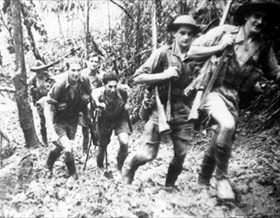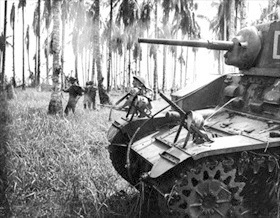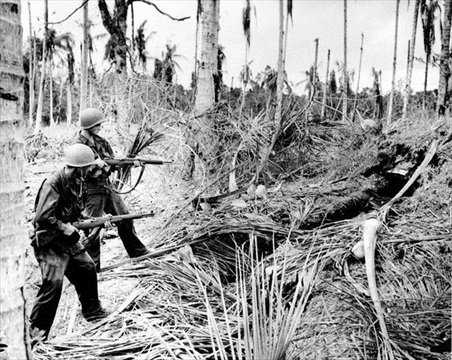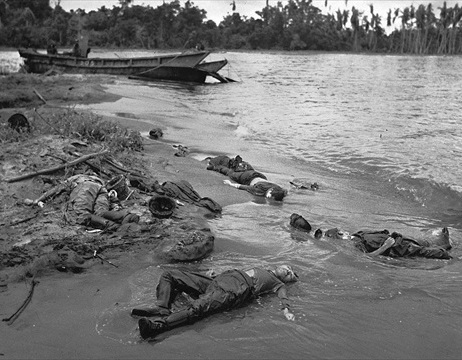MACARTHUR OPENS FIRST GROUND OFFENSIVE AGAINST JAPAN
Southwest Pacific Area HQ, Brisbane, Australia • September 13, 1942
On May 14, 1942, after a voyage of 23 days and 9,000 miles, 12,000 men and equipment of the U.S. 32nd Infantry Division arrived in Australia for the purpose of bulking up the understrength defenses of that country. Gen. Douglas MacArthur, Allied Supreme Commander of all land, naval, and air forces in the Southwest Pacific Area, deemed that the defense of the Australian mainland, his base since fleeing the Philippines, would best be undertaken from the large, mountainous, jungle-covered island of New Guinea, at its narrowest point just over 60 miles across the Torres Strait from Queensland’s Cape York Peninsula. The spear-shaped peninsula was the northernmost tip of the Australian continent. Already the Australians administered the eastern half of New Guinea (an area known today as Papua New Guinea) from the territorial capital at Port Moresby on the island’s southeastern coast. Sadly, though, the Port Moresby garrison in May 1942 was not materially stronger than the one established there earlier in the year, when the Japan’s military juggernaut was busily sweeping aside the colonial regimes of the U.S., British, and Dutch in Southeast Asia and claiming their country’s place in the equatorial sun.
Twenty-one days into July 1942 the Japanese made unopposed incursions into Northeastern New Guinea, establishing forward bases at Buna and neighboring Gona. Buna was the northern end of the 60‑mile-long Kokoda Trail (or Track), a primitive overland mail route to Port Moresby through the nearly impassable Owen Stanley Range defended by a mixed force of 900 Australian and Papuan (mostly native) infantry. Scarcely nine weeks later, on this date, September 13, 1942, MacArthur ordered parts of the U.S. 32nd Division to Port Mosesby, even though the National Guardsmen had less than two months of in-country combat training and not much more than that in the States. This move would become part of the opening ground offensive against Japanese units in the Southwest Pacific. MacArthur glibly expected the Americans to quickly and easily advance on the invaders, who had driven the Australians out of their mountain outpost at Kokoda, secure the rugged Kokoda Trail, and recapture Buna and Gona.
Weeks of bitter and vicious fighting on the Kokoda Trail, where both sides took heavy casualties, helped nudge the weakened Japanese to withdraw over the Owen Stanley Range and make for the northeast coast. Not until November 16, 1942, were U.S. and Australian forces in a position to attack the main Japanese beachheads between Buna and Gona. Since arriving in June, the Japanese had built hundreds of well-camouflaged, reinforced bunkers in mutually supporting positions blocking all available approaches. Combined with the forces that had returned from fighting on the Kokoda Trail, the Japanese defenders initially had nearly 5,500 troops to face the Allies. This rose to about 6,500 later in the battle. The effectiveness of both combatant forces was reduced by an appaling number of tropical illnesses, notably malaria, dengue fever, bush typhus, ulcers, and dysentery, that flourished in the warm, moist jungle.
Allied forces only made significant progress after they were given the tanks and artillery they had long sought. On January 2, 1943, they captured Buna, and on January 22, after frenzied and bloody fighting in extraordinarily difficult conditions, the Allies killed or captured almost the entire Japanese invasion force. Casualties on both sides were extremely high. More than 2,600 Australian and U.S. servicemen were killed (one account places the number at 8,500) and over 17,000 injured or rendered sick during the seven-month Kokoda Trail and Buna-Gona campaigns. Japanese deaths exceeded 13,600. Fighting elsewhere in New Guinea continued through the end of the war.
![]()
New Guinea Campaign: Opening Ground Offensive Against the Japanese
 |  |
Left: Members of the exhausted 39th Australian Infantry Battalion retreating after the Battle of Isurava, late-August or early-September 1942. The 39th Battalion was raised for service in New Guinea in October 1941. Arriving there with little military training in January 1942, the battalion was heavily engaged in the defense of the Kokoda Trail in July and August of that year, during which time they engaged in several desperate encounters with the Japanese as they tried holding out until reinforcements and supplies could be brought up from Port Moresby. Such was the battalion’s involvement in the Kokoda Trail Campaign (July 21 to November 16, 1942) and the subsequent Battle of Buna-Gona (November 16 to January 21, 1942) that by the time it was withdrawn to Port Moresby it could only muster 7 officers and 25 men. Fifteen weeks after its return to Australia in March 1943, the battalion was disbanded.
![]()
Right: Australian forces attack Japanese positions near Buna on the shores of New Guinea’s Huon Gulf, January 7, 1943. Members of the 2/12th Infantry Battalion advance as M3 Stuart tanks from the 2nd Battalion/6th Armored Regiment attack Japanese foxholes and pillboxes, which were expertly camouflaged, had excellent fields of fire, and were connected to each other by shallow crawl trenches that allowed the enemy to move under cover to different positions. An upward-firing .30 caliber machine gun on the light tank sprays treetops to clear them of snipers, whose vantage point enabled them to pick off high-value targets like officers and machine-gunners. Infantry attacking without the close fire support of tanks mounting machine guns and 37mm cannons firing high-explosive shells suffered severely, notwithstanding the M3’s lack of sufficient armor protection to be an effective infantry support tank and the boggy coastal terrain that greatly restricted its range of operations.
 |  |
Left: Two members of the U.S. 32nd Division cautiously fire into a Japanese camouflaged dugout before entering it for inspection during the Allies’ drive on Buna, New Guinea, January 1943.
![]()
Right: Japanese soldiers killed during the grisly final phase of the battle at Buna Mission (Australian government station), New Guinea, January 1943. Even before January the Japanese had lost air and naval superiority, were powerless to disrupt the Allies’ supply chain, and were unable to supply their troops with ammunition, medicine (most of their garrison was debilitated by dysentery and assorted tropical maladies), and food (in December Japanese troopers were reduced to skin and bones, existing on 1‑3/4 ounces (50 grams) of rice and canned meat per day). During December between 20 and 30 Japanese soldiers died each day in Buna’s hospital from the effects of starvation, wound infection, and disease. Officials later estimated that two-thirds of all Japanese military deaths were the result of starvation or lack of medical supplies. An Australian private in the 2/12th Infantry Battalion wrote of the “constant stench of decaying [Japanese] bodies [in Buna]. . . . One could almost taste death in the drinking water.” The beach pictured here, taken by LIFE photojournalist George Strock, was nicknamed “Maggot Beach” owing to the collection of bloated Japanese bodies and maggots found in the sand and surf.
Early 1943 Newsreel: Japanese Routed from Buna Stronghold
![]()

 History buffs, there is good news! The Daily Chronicles of World War II is now available as an ebook for $4.99 on Amazon.com. Containing a year’s worth of dated entries from this website, the ebook brings the story of this tumultuous era to life in a compelling, authoritative, and succinct manner. Featuring inventive navigation aids, the ebook enables readers to instantly move forward or backward by month and date to different dated entries. Simple and elegant! Click
History buffs, there is good news! The Daily Chronicles of World War II is now available as an ebook for $4.99 on Amazon.com. Containing a year’s worth of dated entries from this website, the ebook brings the story of this tumultuous era to life in a compelling, authoritative, and succinct manner. Featuring inventive navigation aids, the ebook enables readers to instantly move forward or backward by month and date to different dated entries. Simple and elegant! Click 











